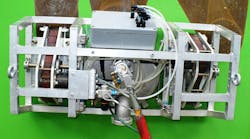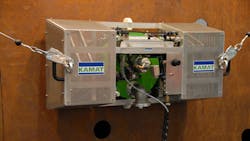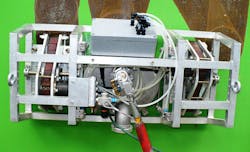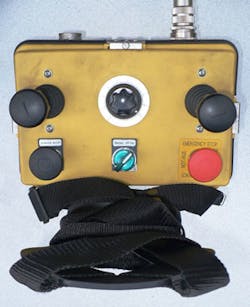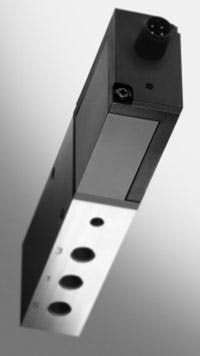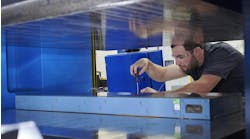This file type includes high resolution graphics and schematics when applicable.
Automated cleaning and paint removal for ship hulls and tanks has always been a tough job. Workers typically use high-pressure nozzles operating at 3,000 bar (43,500 psig) to blast sea life and debris from hull surfaces. Maintenance crews either have to erect scaffolding—moving the structure as cleaning progresses—or use lift trucks and aerial lifts to do the job. The project is labor-intensive, requiring multiple people to work long hours. And the cost to maintain or rent all this equipment can cut deep into a company’s profits.
To alleviate the risks to human safety and high maintenance costs, Kamat GmbH & Co., Witten, Germany, has developed the pneumatic Ship Hull Crawler (SHC 3000), intended for cleaning and removing marine debris, paint, and rust from ships, tanks, and other large steel structures prior to preparing surfaces to resist biofouling—the accumulation of algae, mussels, worms, and other sea organisms that settle on ship’s hulls over time.
Biofouling affects the ship in two important ways. When sea organisms adhere to the hull of the ship, the surface becomes rough, which increases drag and, ultimately, fuel consumption. Even using conventional labor-intensive techniques pays big dividends because cleaning a ship’s hull can slash energy consumption by 40%. This cost savings is why shipping companies regularly pay large sums to have tankers and container ships cleaned. The second concern is the danger of corrosion on the hull, which increases from the environment generated by the biofilm that settles on the ship’s outer shell.
Driven by Pneumatics
The SHC 3000 uses high-pressure guns equipped with rotating nozzles for quick and versatile cleaning of surfaces. It is housed in an aluminum frame, and the swivel nozzle assembly can be removed and used on its own for small jobs or for working in confined spaces. The swivel assembly is rotated by an air motor to provide high-pressure cleaning of large areas. The rotational speed of the air motor is controlled proportionally to achieve optimum cleaning effectiveness.
The crawler itself is held securely against the ship’s hull or other steel surface by four rows of strong magnets positioned close to but not touching the steel surface. This is important because reaction forces from the high-pressure water jets would act to push the machine away from the surface.
The crawler also uses pneumatic motors to move around the steel surface through a crawler drive—similar to what is used in skid-steer loaders. Each of two pneumatic motors drives a sprocket that engages a plastic-coated chain. Each chain is driven independently in either direction. Turning is accomplished by driving one motor faster than the other, and the crawler can even rotate on its own axis by driving one motor forward and the other backward.
Direction and speed of each motor is controlled proportionally by a 5/3 way, normally closed valve, specifically, Festo’s MPYE-5-178HF-010-B. Speed can be controlled from 0 to 4.5 m/min (0 to 14.8 ft/min), and a higher speed range 0 to 9 m/min (29.5 ft/min) is offered by Kamat as an option. Because the crawler operates via remote control, the user is at a safe distance from the working area.
Although the crawler is designed to move over relatively smooth surfaces, it can negotiate obstacles like high welds and uneven plate connections. And because it does not depend on a vacuum to adhere to the surface (unlike other devices used for this purpose), the crawler can move over holes and perforated surfaces. It can also reach over the end of a surface (for example, at the upper railing of a ship). The crawler can also move over curved surfaces having a radius of 1 m or more. This lets the SHC 3000 move vertically down a hull to where it becomes upside down. Steel guide ropes provide an additional safeguard to prevent the crawler from falling off of surfaces.
Another optional feature is an external vacuum device to remove debris by suction. Other options include an external power supply, cable reels that connect to the power supply as well as the remote control console, and adapters for cable extensions if needed.
Kamat found pneumatics the most practical solution for the SHC 3000. The air motors provide a smaller and lighter solution than electric motors, overcome the concern of heat buildup, and eliminate the potential hazard of high-voltage power lines in wet working environments. A pneumatic air supply is easily accommodated simply renting a mobile air compressor.
For more information on the SHC 3000 and other products and services offered by Kamat, visit www.KAMAT.de.
This file type includes high resolution graphics and schematics when applicable.
